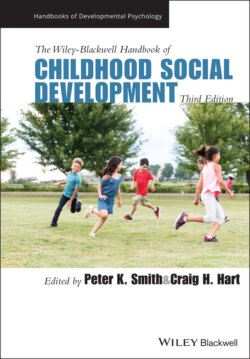Читать книгу The Wiley-Blackwell Handbook of Childhood Social Development - Группа авторов - Страница 52
Adoption studies
ОглавлениеAnother family‐based approach that allows estimation of the effects of genetic and environmental influences on individual differences in a trait is the adoption approach. In adoption studies, phenotypic similarities (similarities on a specific trait) can be compared between adopted children and their biological and adoptive parents; and between siblings from biological families and siblings from adoptive families. Adoption studies are also a powerful tool to study interactions between genetic and environmental factors.
In line with twin studies, adoption studies have demonstrated substantial effects of genetic factors on the development of social behavior. Studies of externalizing problems in adopted children of age 10–15 years, and their biological and nonbiological siblings, showed that externalizing behavior is mostly explained by genetic factors (65%). Similarly to the results of twin studies, heritability of aggressive behavior (70%) was higher than heritability of delinquent behavior (39%) (Van den Oord et al., 1994). However, in the Colorado Adoption Project, which also compared biological and nonbiological siblings, heritability of aggression (24–49%) and delinquent behavior (17–36%), assessed by parental and teachers’ reports, was lower (Deater‐Deckard & Plomin, 1999). Another example of an adoption study is the Early Growth and Development Study (EGDS), a US nationwide, prospective study of birth parents and adoptive families (https://egds.la.psu.edu/). A study that used EGDS data from 346 linked triads (birth mother, adoptive parents, adopted child) in order to assess externalizing behavioral problems, such as aggression and defiance, when children were 18, 27, and 54 months of age (Kerr et al., 2013). The results of this study indicated that biological mothers’ histories of major depression and adult antisocial behavior were found to confer risk for child externalizing behaviors at age 18 months, consistent with the role of genetic influences on child behavioral problems.
With trends toward selective adoption and the diminishing frequency of adoptions in many developed countries, including the United Kingdom and the United States, adoption studies are becoming a less feasible method of genetically informative investigations. However, the increased rate of reconstituted families (families composed of both siblings and half siblings) may offer a new way to evaluate the role of genetic factors in the transmission of complex disorders (Risch et al., 2014).
To summarize, there is growing evidence, from both molecular genetic studies and family‐based (twin and adoption) studies, for the complex polygenic architecture of sociobehavioral phenotypes, such as antisocial behavior. Future studies are needed to uncover the role of specific genetic variants across the whole genome, and their complex interplay with various environmental factors.
